Kuwait Cold Chain Market Outlook to 2029
By Market Structure, By End-Users, By Type of Temperature (Chilled, Frozen), By Product Category (Fruits & Vegetables, Dairy Products, Meat & Seafood, Pharmaceuticals), and By Region.
- Product Code: TDR0204
- Region: Middle East
- Published on: June 2025
- Total Pages: 110
Introducing the World's FirstPay-Per-Section Market Reports
Why pay for the full report when you need just a part?
Start Building Your Report
Scroll down to see available sections
Report Summary
The report titled “Kuwait Cold Chain Market Outlook to 2029 – By Market Structure, By End-Users, By Type of Temperature (Chilled, Frozen), By Product Category (Fruits & Vegetables, Dairy Products, Meat & Seafood, Pharmaceuticals), and By Region.” provides a comprehensive analysis of the cold chain industry in Kuwait. The report covers an overview and genesis of the industry, overall market size in terms of revenue, market segmentation; trends and developments, regulatory landscape, customer level profiling, issues and challenges, and comparative landscape including competition scenario, cross comparison, opportunities and bottlenecks, and company profiling of major players in the Cold Chain Market. The report concludes with future market projections based on revenues, by market segments, by temperature type, by product category, cause and effect relationship, and success case studies highlighting the major opportunities and cautions.
Kuwait Cold Chain Market Overview and Size
The Kuwait cold chain market reached a valuation of USD 950 Million in 2023, driven by the increasing demand for perishable food products, pharmaceutical products requiring temperature-controlled logistics, and the rapid expansion of organized retail and e-commerce. The market is characterized by major players such as Agility Logistics, Kuehne + Nagel, DHL, Al Rai Logistics, and Kuwait Refrigerated Transport Company. These companies are recognized for their strong cold storage networks, integrated supply chain solutions, and technological innovations.
In 2023, Agility launched an upgraded temperature-controlled warehouse facility in Sulaibiya Industrial Area to cater to the rising demand from pharmaceutical and food industries. Kuwait City, Hawally, and Farwaniya emerge as the key markets due to their concentrated economic activities and proximity to major consumer bases.
Market Size for Kuwait Cold Chain Industry on the Basis of Revenues in USD Million, 2018-2024
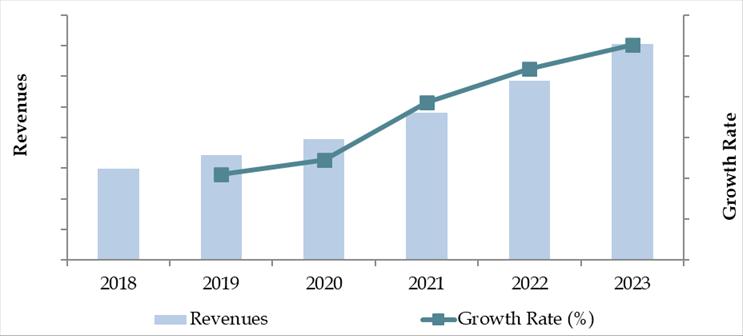
What Factors are Leading to the Growth of Kuwait Cold Chain Market:
Growth in Imports of Perishable Goods: Kuwait heavily relies on imports for its food and pharmaceutical needs. In 2023, nearly 85% of the food consumed was imported, necessitating advanced cold chain infrastructure to preserve quality and safety standards during storage and transportation.
Healthcare Sector Expansion: With healthcare reforms and increasing investment in pharmaceutical products, demand for cold storage and transportation services for vaccines, biologics, and temperature-sensitive medicines rose by 18% from 2022 to 2023. Kuwait’s Ministry of Health mandates strict cold chain compliance for pharmaceutical logistics, further pushing the sector’s growth.
Government Initiatives: The Kuwait Vision 2035 initiative includes a strong focus on logistics infrastructure development, including cold chain capabilities. Investments in industrial zones like Shadadiya and South Sabah Al-Ahmad will support logistics sector modernization, including temperature-controlled warehouses.
Which Industry Challenges Have Impacted the Growth for Kuwait Cold Chain Market
High Operational Costs: Maintaining cold storage facilities and temperature-controlled transportation fleets incurs significant operational expenses. Electricity costs in Kuwait, though subsidized, remain high for industrial users. In 2023, it was estimated that operational costs accounted for nearly 45% of a cold chain company’s total expenditure, making profitability challenging, particularly for small and mid-sized players.
Infrastructure Gaps: Despite investments, there is still a shortage of modern cold storage facilities outside Kuwait City and major urban centers. Approximately 30% of perishable imports experience minor spoilage due to inadequate last-mile cold chain infrastructure, as reported in 2023, leading to increased wastage and reduced shelf life for sensitive products.
Dependence on Imported Technology and Equipment: The cold chain industry in Kuwait relies heavily on imported refrigeration equipment, tracking systems, and specialized vehicles. In 2023, over 85% of critical cold chain equipment was imported, causing delays and higher costs due to global supply chain disruptions, especially during post-pandemic recovery phases.
What are the Regulations and Initiatives which have Governed the Market:
Temperature Compliance Regulations: The Public Authority for Food and Nutrition (PAFN) in Kuwait enforces strict regulations for cold storage and transport of food and pharmaceutical products. Companies must maintain temperature logs and undergo regular inspections. In 2023, around 78% of cold chain operators passed regulatory audits without penalties, indicating improved compliance standards across the sector.
Import Regulations for Perishable Goods: Kuwait’s Customs authorities have set strict timelines for clearance of perishable cargo. Imported food products must clear customs within 48 hours to avoid spoilage penalties. In 2023, the average clearance time for perishables improved to 42 hours, helping cold chain providers minimize risks related to customs delays.
Government Investment in Logistics Zones: As part of Kuwait Vision 2035, the government has allocated significant investments towards developing logistics zones in South Sabah Al-Ahmad and Shadadiya, including dedicated cold storage parks. These initiatives aim to increase the organized cold chain space by 20% by 2027, encouraging more investments from private players and reducing dependency on ad-hoc storage solutions.
Kuwait Cold Chain Market Segmentation
By Market Structure: Organized cold chain service providers dominate the market, owing to their investments in modern infrastructure, compliance with international standards, and integrated logistics solutions. Companies such as Agility, Al Rai Logistics, and Kuehne + Nagel lead the organized sector. Unorganized players still operate in fragmented spaces, primarily handling small-scale cold storage and short-haul refrigerated transport with basic facilities.
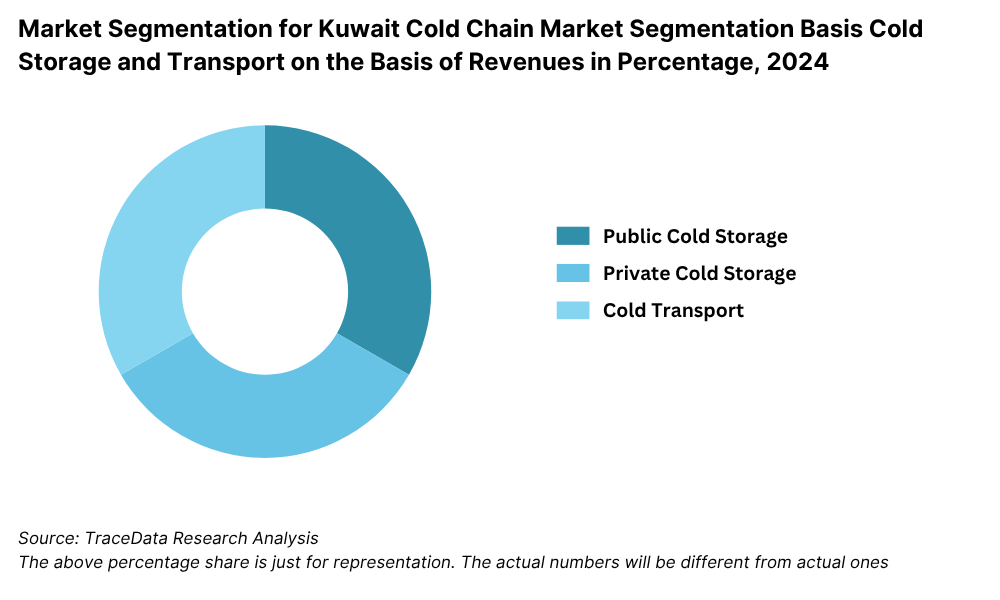
By End-User Industry: The Food & Beverage sector is the largest consumer of cold chain services, driven by Kuwait’s heavy reliance on imported fruits, vegetables, dairy, and seafood. The Pharmaceutical sector follows, propelled by the rise in demand for vaccines, biologics, and temperature-sensitive medicines. Retail and e-commerce companies are emerging as key users due to the rise in online grocery delivery and frozen food demand.
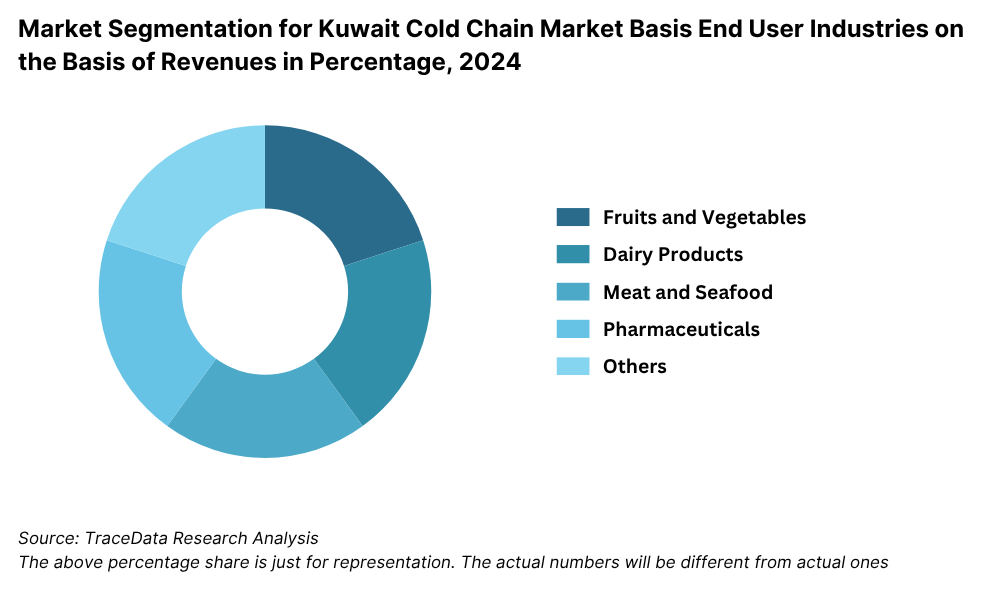
By Temperature Type: The Frozen category (for meat, seafood, and frozen foods) accounts for the largest share due to Kuwait's high import volume of frozen consumables. Chilled products (like fresh produce and dairy) form a smaller but growing share, especially with rising consumer demand for fresh and organic produce through modern retail and online platforms.
Competitive Landscape in Kuwait Cold Chain Market
The Kuwait cold chain market is moderately concentrated, with a few major players holding significant market share. However, the growing demand for modern logistics services and stricter regulatory requirements have paved the way for new entrants and technological innovation. Key players such as Agility Logistics, Al Rai Logistics, Kuehne + Nagel, DHL, and Kuwait Refrigerated Transport Company continue to lead the market, offering end-to-end cold chain solutions tailored to Kuwait’s import-driven economy.
| Company Name | Founding Year | Original Headquarters |
| Agility Logistics (Cold Chain Division) | 1979 | Kuwait City, Kuwait |
| KGL Logistics (Kuwait & Gulf Link) | 2000 | Kuwait City, Kuwait |
| Al-Rashed International Shipping Co. | 1911 | Kuwait City, Kuwait |
| Global Freight Systems (GFS Kuwait) | 2001 | Kuwait City, Kuwait |
| Kuwait Proteins Company (Food Cold Chain) | 1982 | Kuwait City, Kuwait |
| Refrigeration Industries & Storage Co. (RISCO) | 1976 | Kuwait City, Kuwait |
| AlMulla Group Logistics | 1938 | Kuwait City, Kuwait |
| MRC Logistics (Cold Chain for Pharma & Food) | 1987 | Kuwait City, Kuwait |
| DHL Global Forwarding Kuwait | 1969 (Kuwait: ~1980s) | Bonn, Germany |
| DB Schenker Kuwait | 1872 (Kuwait: ~2000s) | Essen, Germany |
| Kuehne + Nagel Kuwait (Cold Chain Services) | 1890 (Kuwait: ~2000s) | Schindellegi, Switzerland |
| CEVA Logistics Kuwait | 2006 (Kuwait: ~2010s) | Marseille, France |
| Maersk Kuwait (Cold Chain Containers) | 1904 (Kuwait: ~2000s) | Copenhagen, Denmark |
| FedEx Kuwait (via local partner) | 1971 (Kuwait: ~1990s) | Memphis, USA |
| UPS Kuwait (via authorized provider) | 1907 (Kuwait: ~1990s) | Atlanta, USA |
Some of the recent competitor trends and key information about competitors include:
Agility Logistics: In 2023, Agility expanded its temperature-controlled warehouse space by 25% with a new facility in Sulaibiya, catering to pharmaceuticals and frozen food logistics. The company also invested in IoT-based monitoring systems for real-time tracking of temperature-sensitive shipments.
Al Rai Logistics: Focused on strengthening its cold chain fleet, Al Rai Logistics added 50 new refrigerated trucks in 2023. The company reported a 20% increase in cold chain revenue driven by partnerships with major grocery chains and pharmaceutical distributors.
Kuehne + Nagel: Kuehne + Nagel reported a 15% growth in its Middle East cold chain logistics operations in 2023, with Kuwait contributing significantly through its food imports business. The company’s focus remains on pharma cold chain solutions, with an emphasis on GDP (Good Distribution Practices) compliance.
DHL Global Forwarding: DHL launched specialized cold chain solutions in Kuwait in 2023 targeting the life sciences and healthcare sector, supported by dedicated staff trained in handling temperature-controlled shipments. The company also introduced automated warehouse management systems to improve operational efficiency.
Kuwait Refrigerated Transport Company: As one of the oldest players in the market, Kuwait Refrigerated Transport Company modernized its fleet by retrofitting trucks with multi-temperature compartments in 2023. The company is expanding its services to include last-mile cold delivery for major food retail chains.
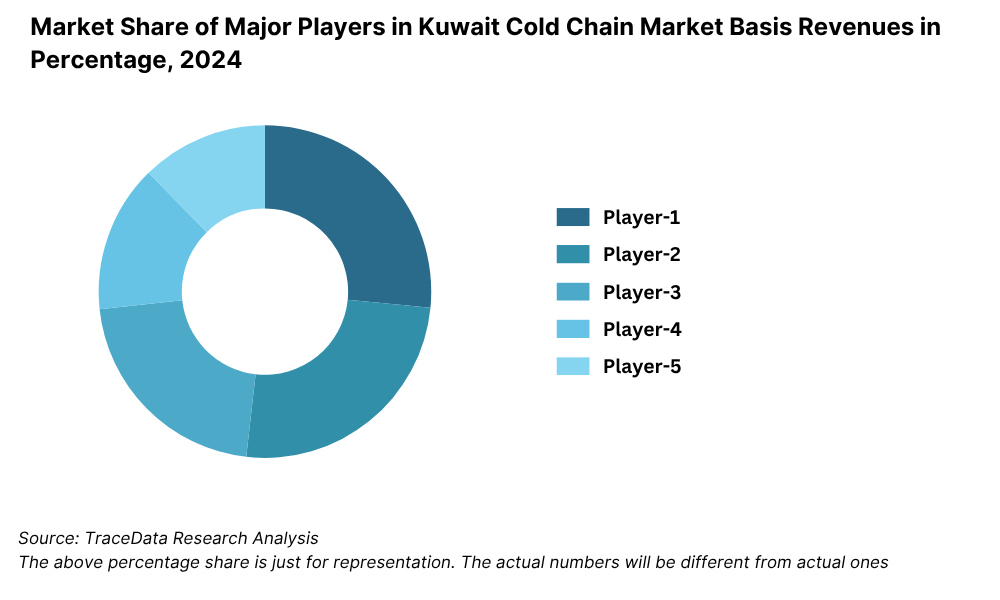
What Lies Ahead for Kuwait Cold Chain Market?
The Kuwait cold chain market is projected to witness steady growth by 2029, exhibiting a healthy CAGR during the forecast period. This growth is expected to be driven by the expansion of the food and pharmaceutical sectors, technological advancements, and increased investments in logistics infrastructure aligned with Kuwait Vision 2035.
Expansion of Pharmaceutical Cold Chain: With increasing healthcare reforms and demand for temperature-sensitive medicines, Kuwait’s pharmaceutical cold chain segment is expected to see strong double-digit growth. Investments in specialized pharma-grade warehouses and GDP-certified logistics services will fuel this trend, ensuring reliable cold storage and distribution across the country.
Adoption of Advanced Monitoring Technologies: The integration of IoT, RFID tracking, and AI-based temperature monitoring systems is anticipated to become more widespread. These technologies will enhance supply chain visibility, reduce spoilage rates, and ensure regulatory compliance, giving competitive advantage to early adopters.
Growth of Organized Food Retail and E-Commerce: The rise of hypermarkets, online grocery platforms, and quick-commerce services will increase the need for sophisticated cold storage and rapid cold transport services. Companies focusing on last-mile refrigerated logistics and fast fulfillment for perishables are likely to dominate the evolving demand landscape.
Development of Specialized Cold Storage Zones: Kuwait’s government-led initiatives to develop dedicated logistics parks with built-in cold storage capabilities in areas like Shadadiya and South Sabah Al-Ahmad will support market expansion. These specialized zones will attract global 3PLs and regional logistics players, fostering competition and driving efficiency improvements.
Future Outlook and Projections for Kuwait Cold Chain Market on the Basis of Revenues in USD Million, 2024-2029
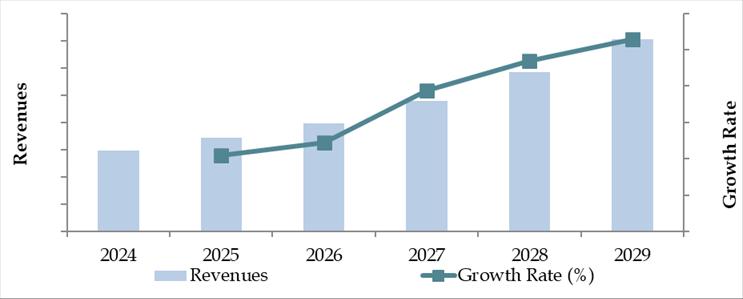
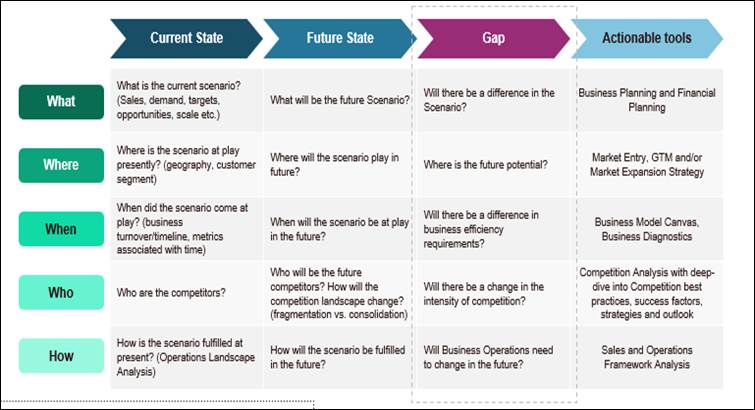
Kuwait Cold Chain Market Segmentation
By Market Structure:
Cold Storage Providers
Cold Transportation Companies
Integrated Cold Chain Solution Providers
Organized Sector
Unorganized Sector
By End-User Industry:
Food & Beverage
Pharmaceuticals
Retail & E-Commerce
Hospitality (Hotels, Restaurants, Catering - HoReCa)
Industrial and Chemicals (Specialized Products)
By Temperature Type:
Chilled (0°C to +15°C)
Frozen (Below 0°C)
By Product Category:
Fruits & Vegetables
Dairy Products
Meat & Seafood
Pharmaceuticals
Processed Foods
Others (Flowers, Specialty Chemicals)
By Region:
Kuwait City
Hawally
Farwaniya
Al Ahmadi
Jahra
Mubarak Al-Kabeer
Players Mentioned in the Report:
Agility Logistics
Kuehne + Nagel Kuwait
DHL Global Forwarding (Cold Chain Division)
Maersk Cold Chain Services
Global Star Cold Chain Logistics
Four Winds Cold Chain
United Warehouse Company – Cold Storage
National Aviation Services (NAS) – Cold Chain Solutions
Al‑Wala Logistics – Refrigerated Transport
Crown Cold Chain – Refrigerated Warehousing
Key Target Audience:
Cold Storage Companies
Refrigerated Transportation Providers
Food Importers and Distributors
Pharmaceutical Companies
E-Commerce and Retail Companies
Logistics Infrastructure Developers
Regulatory Authorities (e.g., Public Authority for Food and Nutrition - PAFN)
Research and Development Institutions
Time Period:
Historical Period: 2018-2023
Base Year: 2024
Forecast Period: 2024-2029
Report Coverage
Choose individual sections to purchase. Mix and match as you like.
- -
- -
- $250
- $100
- $250
6.1. Revenues, 2018-2024P
$3007.1. By Cold Storage and Cold Transport, 2023-2024P
7.2. By End-User Application (Dairy Products, Meat and Seafood, Pharmaceuticals, Fruits and Vegetables and Others), 2023-2024P
7.3. By Ownership (Owned and 3PL Cold Chain Facilities), 2023-2024P
$400- $100
- $200
10.1. Kuwait Cold Storage Market Size
10.1.1. By Revenue, 2018-2024P
10.1.2. By Number of Pallets, 2018-2024P
10.2. Kuwait Cold Storage Market Segmentation
10.2.1. By Temperature Range (Ambient, Chilled and Frozen), 2023-2024P
10.2.2. By End-User Application (Dairy Products, Meat and Seafood, Pharmaceuticals, Fruits and Vegetables and Others), 2023-2024P
10.2.3. By Major Cities, 2023-2024P
10.3. Kuwait Cold Storage Market Future Outlook and Projections, 2025-2029
10.3.1. By Temperature Range (Ambient, Chilled and Frozen), 2025-2029
10.3.2. By Major Cities, 2025-2029
$30011.1. Kuwait Cold Transport Market Size (By Revenue and Number of Reefer Trucks), 2018-2024P
11.2. Kuwait Cold Transport Market Segmentation
11.2.1. By Mode of Transportation (Land, Sea and Air), 2023-2024P
11.2.2. By Location (Domestic and International), 2023-2024P
11.3. Kuwait Cold Transport Market Future Outlook and Projections, 2025-2029
11.3.1. By Mode of Transport (Land, Sea and Air), 2025-2029
11.3.2. By Location (Domestic and International), 2025-2029
$30012.1. Trends and Developments in Kuwait Cold Chain Market
12.2. Issues and Challenges in Kuwait Cold Chain Market
12.3. Decision Making Parameters for End Users in Kuwait Cold Chain Market
12.4. SWOT Analysis of Kuwait Cold Chain Industry
12.5. Government Regulations and Associations in Kuwait Cold Chain Market
12.6. Macroeconomic Factors Impacting Kuwait Cold Chain Market
$20013.1. Parameters to be covered for Each End Users to Determine Business Potential:
13.1.1. Production Clusters
13.1.2. Market Demand, Major Products Stored, Cold Storage Companies in Guwahati catering to End Users
13.1.3. Location Preference for Each End User and their Production Plants, Preferences for Outsourcing and Captive Facility, Services Required, Facility Preferences, Decision Making Parameters
13.1.4. Cross comparison of leading end users/companies based on Headquarters, Manufacturing Plants, Products Stored, Major Products, Total Production, Cold Chain Partner, Facility Outsourced/Captive, Pallets Owned/Hired, Contact Person, Address and others
$500- $250
- $150
16.1. Competitive Landscape in Kuwait Cold Chain Market
16.2. Competition Scenario in Kuwait Cold Chain Market (Competition Stage, Major Players, Competing Parameters)
16.3. Key Metrics (Temperature Range, Pallet Position, Prices Charged, Occupancy Rate, Revenue (2023) and Employee Base) for Major Players in Kuwait Cold Chain Market
16.4. Company Profiles of Major Companies in Kuwait Cold Chain Market (Year of Establishment, Company Overview, Service Offered, USP, Warehousing Facilities, Warehousing Price, Cold Storage by location, Occupancy Rate, Major Clientele, Industries Catered, Employee Base, Temperature Range, Topline OPEX*, Revenue, Recent Developments, Future Strategies)
16.5. Strength and Weakness
16.6. Operating Model Analysis Framework
16.7. Gartner Magic Quadrant
16.8. Bowmans Strategic Clock for Competitive Advantage
$20017.1. Revenues, 2025-2029
$30018.1. By Cold Storage and Cold Transport, 2025-2029
18.2. By End-User Application (Dairy Products, Meat and Seafood, Pharmaceuticals, Fruits and Vegetables and Others), 2025-2029
18.3. By Ownership (Owned and 3PL Cold Chain Facilities), 2025-2029
18.4. Recommendation
18.5. Opportunity Analysis
$400
Research Methodology
Step 1: Ecosystem Creation
Map the ecosystem and identify all the demand side and supply side entities for Kuwait Cold Chain Market. Based on this ecosystem, we shortlist leading 5–6 major service providers in the country based on their financial information, warehouse capacity, fleet size, and service capabilities.
Sourcing is made through industry articles, multiple secondary, and proprietary databases to perform desk research around the market to collate industry-level information, including cold storage capacities, temperature control compliance rates, and end-user demand trends.
Step 2: Desk Research
Subsequently, we engage in an exhaustive desk research process by referencing diverse secondary and proprietary databases. This approach enables us to conduct a thorough analysis of the market, aggregating industry-level insights.
We delve into aspects like total cold storage capacity, major transportation corridors, volume handled by cold logistics providers, and service pricing trends.
We supplement this with detailed examinations of company-level data, relying on sources like press releases, annual reports, industry news, and regulatory filings. This process constructs a foundational understanding of both the market and the major entities operating within it.
Step 3: Primary Research
We initiate a series of in-depth interviews with C-level executives, warehouse managers, fleet operations heads, and other stakeholders representing various Kuwait Cold Chain Market companies and end-users (like food distributors and pharmaceutical companies).
This interview process serves a multi-faceted purpose: to validate market hypotheses, authenticate statistical data, and extract valuable operational and financial insights from these industry representatives.
A bottom-to-top approach is undertaken to evaluate cold storage space utilization, fleet volumes, and market shares, thereby aggregating to the overall market assessment.As part of our validation strategy, our team executes disguised interviews wherein we approach each company under the guise of potential customers. This enables us to validate operational, pricing, and financial information shared by company executives, corroborating this against what is available in secondary databases.
These interactions provide a comprehensive understanding of cold chain processes, value chain economics, pricing models, compliance practices, and emerging challenges.
Step 4: Sanity Check
- Bottom-to-top and top-to-bottom analysis, along with market size modeling exercises, are undertaken to assess and ensure the sanity and consistency of the final market size estimations and projections.
FAQs
1. What is the potential for the Kuwait Cold Chain Market?
The Kuwait cold chain market is poised for significant growth, reaching a valuation of USD 950 Million in 2023. Growth is driven by the increasing demand for perishable food imports, rising pharmaceutical needs, and the expansion of e-commerce platforms requiring robust cold logistics solutions. Future potential is further bolstered by government investments in logistics infrastructure under Kuwait Vision 2035 and a shift toward advanced temperature-controlled supply chains.
2. Who are the Key Players in the Kuwait Cold Chain Market?
The Kuwait Cold Chain Market features several key players, including Agility Logistics, Al Rai Logistics, Kuehne + Nagel, DHL Global Forwarding, and Kuwait Refrigerated Transport Company. These companies dominate the market owing to their extensive cold storage facilities, technologically advanced transport fleets, and established relationships with major food and pharmaceutical importers.
3. What are the Growth Drivers for the Kuwait Cold Chain Market?
Key growth drivers include the reliance on imported perishables, growing healthcare sector needs for temperature-controlled pharmaceuticals, technological adoption like IoT-based monitoring systems, and the rising penetration of online grocery and food delivery platforms. Government initiatives to develop specialized cold chain hubs and logistic parks also significantly contribute to market expansion.
4. What are the Challenges in the Kuwait Cold Chain Market?
The Kuwait Cold Chain Market faces several challenges, including high operational and energy costs associated with maintaining cold storage facilities, infrastructure gaps in remote regions, and heavy reliance on imported equipment and technologies. Regulatory compliance for temperature-sensitive logistics and the need for greater sustainability practices also pose operational challenges for market players.